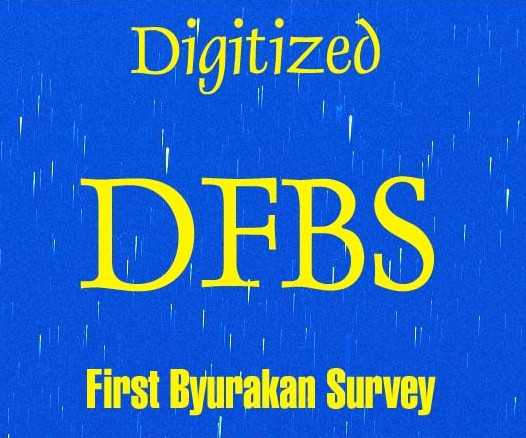|
UV-excess (Markarian)
galaxies
The FBS was conducted originally for search
of galaxies with UV-excess. The discovery of 1515 UV-excess (UVX)
galaxies by Markarian and
colleagues (later called Markarian galaxies) was the first and the most important work
based on the FBS plates (Markarian 1967, Markarian et al. 1989). There
are more than 200 Seyferts, dozens of QSOs, few hundreds of starburst and
HII galaxies, BL Lac objects, radio, IR and X-ray sources among them
(Mazzarella & Balzano 1986; Markarian et al. 1997). During the last
30 years more than 2500 scientific papers have been published on study of
these objects. There are many Markarian galaxies, which are subject of
study for understanding of AGN phenomenon, starburst activity and
evolution of galaxies, high-luminosity IR radiation, AGN variability,
double and multiple structure of the nucleus, composite spectrum AGN, galaxy
interactions and merging, connection between different types of active
galaxies, early stages of evolution of galaxies (some Markarian galaxies
are BCDGs), and other important topics of modern extragalactic astronomy.
Study of Markarian galaxies brought to discovery of many new Seyferts and
spectral classification of this type of objects (Weedman & Khachikian
1971).
FBS blue stellar
objects
The second part of the FBS was devoted to the
discovery and investigation of the blue (UVX) stellar
objects. It was carried out
by Abrahamian and Mickaelian in 1987-1994 (Abrahamian & Mickaelian
1996, Mickaelian 1994, and references therein) in 278 FBS fields, in a
4009 sq. degrees area of the FBS (+33<delta<+45 and
+61<delta<+90). The main purpose of this work was discovery of new
bright QSOs (as Markarian's survey was aimed only on extended objects),
Seyferts, other compact galaxies, planetary nebulae nuclei, cataclysmic
variables (CV), white dwarfs (WD), subdwarfs, and other peculiar stellar
objects (Abrahamian et al. 1999; Mickaelian 2000). 1103 objects have been
selected, including 716 new blue stellar objects. Subsamples of candidate
QSOs, WDs, CVs have been made up and spectral observations have been
carried out for identification of the objects. 11 new bright QSOs have
been discovered already among these objects (Mickaelian et al 1999),
proving that FBS can provide data for enriching our knowledge on Local
Universe. The local density of QSOs and the completeness of the Bright Quasar
Survey (BQS) is re-estimated.
FBS late-type stars
A survey on late-type stars on the FBS plates is being carried out since
1987 by Abrahamian and Gigoyan (ex. Abrahamian et al 1997 and references
therein). 518 late M-type and carbon stars have been selected already in
an area of 4569 sq. degrees in 12 zones, including 355 new ones. Surveys
on carbon stars at high galactic latitudes are very rare. Discovery and
study of such objects is necessary for study of the kinematics and
chemical composition of the Galactic halo. Besides, many objects with
extended dust shells, as well as extremely rare two new dwarf carbon
stars have been discovered.
Optical
identification of IRAS sources
Works on selection of galaxies, blue stellar
objects (including QSOs and Seyferts) and late-type stars lead to a new
program of optical identifications of IRAS sources on the basis of the FBS plates (Mickaelian 1995). Since 1995, 1577 previously
unidentified IRAS point sources (IRAS 1988, 1989) have been optically
identified in the area +61<delta<+90 with a surface of 1487 sq.
degrees (Mickaelian 2001). In this area, FBS plates have better limiting
magnitudes (in average: 18.1 in V). 1178 of the identified sources are
galaxies. Observations revealed many interesting objects, including
Seyferts and LINERs and composite spectrum AGNs (Mickaelian et al. 1998,
Balayan et al. 2001). IRAS galaxies contain AGNs, high-luminosity IR
galaxies (LIGs, ULIGs, HLIGs), groups of galaxies (including compact
ones), interacting and merging galaxies, etc. The subsample of galactic
objects is also interesting, as it contains new planetary nebulae, AGB
stars, late M and carbon stars. Some of them have excessive IR fluxes,
mentioning on extended dust shells, as well as a number of stars show evidence
of variability. Study of the new sample of IRAS galaxies, especially the
high-luminosity IR galaxies, may lead to understanding of
interrelationship between AGN and starburst activity induced by galaxy
interactions and merging.
SUMMARY
OF MAIN PROJECTS BASED ON THE FBS
Markarian
survey 1515 UVX galaxies
FBS
blue stellar objects 1103 BSOs, including QSOs, Sy,
WD, sd, CV, etc.
FBS
late-type stars 813 M-type and carbon stars
IRAS
identifications 1577 IRAS PSC sources, BIG and
BIS objects
REFERENCES
Abrahamian
H.V. and Mickaelian A.M., 1996, Astrophysics, 39, 531.
Abrahamian
H.V., Gigoyan K.S., Hambarian V.V., Azzopardi M., 1997, Astrophysics, 40,
131.
Abrahamian,
H.V., Mickaelian, A.M., Lipovetsky, V.A., Stepanian, J.A., 1999, Catalog
No. II/223 at CDS, Strasbourg, at http://vizier.u-strasbg.fr/cgi-bin/VizieR?-source=II/223/fbs2.
Balayan
S.K., Hakopian S.A., Mickaelian A.M., Burenkov A.N., 2001, Astronomy
Letters, 27, 284
IRAS
Catalogs and Atlases, 1988, 2. The Point Source Catalog. Declination
90>d>30, Joint IRAS Science Working Group, NASA, Washington, DC: US
GPO.
IRAS
Faint Source Catalog, 1989, |b|>10, Version 2, On Optical Disc,
"Selected Astronomical Catalogs", Supplied by NASA, Vol. 1.
Markarian
B.E., 1967, Astrophysics, 3, 55.
Markarian
B.E., Lipovetski V.A., Stepanian J.A., Erastova L.K., Shapovalova A.I.,
1989, Commun. Special Astrophys. Obs., 62, 5.
Markarian
B.E., Lipovetsky V.A., Stepanian J.A., 1997, Catalog No. VII/172 at CDS,
at http://vizier.u-strasbg.fr/viz-bin/VizieR?-source=VII/172.
Mazzarella
J.M., Balzano V.A., 1986, A Catalog of Markarian Galaxies, Astrophys. J.
Suppl. Ser., 62, 751.
Mickaelian
A.M., 1994, Discovery and Investigation of the Blue Stellar Objects of
the First Byurakan Survey, Ph.D. Thesis, Byurakan.
Mickaelian
A.M., 1995, Astrophysics, 38, 349.
Mickaelian
A.M., 2000, Astron. Astrophys. Transactions, 18, 557.
Mickaelian
A.M., 2001, Astrophysics, 45, 288.
Mickaelian
A.M., Gigoyan K.S., 2003, Catalog No.III/237 at CDS, Strasbourg, at http://vizier.u-strasbg.fr/viz-bin/VizieR?-source=BIS.
Mickaelian
A.M, Hakopian S.A., Balayan S.K., Burenkov A.N., 1998, Astronomy Letters,
24, 635.
Mickaelian
A.M, Goncalves A.C., Veron-Cetty M.P., Veron P., 1999, Astrofizika, 42,
5.
Weedman D.W. and Khachikian E.Ye.,
1971, Astrophysics, 7, 389.
|
